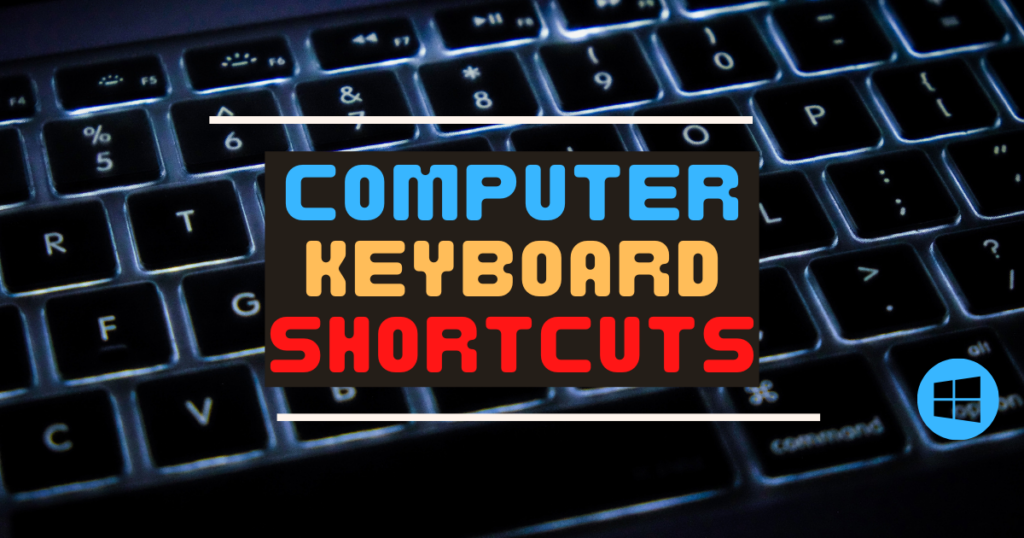Unlocking Efficiency: A Comprehensive Guide to Windows Keyboard Shortcuts for Increased Productivity

In the realm of digital productivity, the keyboard stands as a powerful tool, and mastering Windows keyboard shortcuts is the key to unlocking a world of efficiency and convenience. Whether you’re a casual user or a seasoned professional, incorporating keyboard shortcuts into your daily workflow can significantly enhance your productivity, allowing you to navigate, execute commands, and perform tasks with remarkable speed. This comprehensive guide delves into an extensive array of Windows keyboard shortcuts, providing insights, tips, and practical applications to empower users in maximizing their efficiency.
1. Navigating the Interface: Streamlining Your Experience
Efficient navigation is the foundation of productivity. Windows offers a plethora of keyboard shortcuts to help users seamlessly move through the interface and access essential features.
a. Basic Navigation Shortcuts: Mastering the Essentials
- Windows Key (Win): Open or close the Start menu.
- Alt + Tab: Switch between open applications.
- Win + Tab: Activate Task View for a visual representation of open windows.
- Ctrl + Esc: Open the Start menu (alternative to pressing the Windows key).
b. Window Management Shortcuts: Multitasking Made Easy
- Win + Arrow Keys: Snap windows to the sides or corners of the screen.
- Alt + F4: Close the active window.
- Win + D: Show or hide the desktop.
- Ctrl + Shift + Esc: Open Task Manager directly.
2. Text Editing and Formatting: Crafting Documents Efficiently
For users dealing with documents, emails, or any text-based tasks, mastering text editing and formatting shortcuts can significantly boost productivity.
a. Basic Text Editing Shortcuts: Speeding Up Daily Tasks
- Ctrl + C, Ctrl + X, Ctrl + V: Copy, cut, and paste respectively.
- Ctrl + Z, Ctrl + Y: Undo and redo actions.
- Ctrl + A: Select all text or items in a document or folder.
- Ctrl + F: Open the Find dialog for searching within documents.
b. Text Formatting Shortcuts: Polishing Your Presentation
- Ctrl + B, Ctrl + I, Ctrl + U: Bold, italicize, and underline text.
- Ctrl + Shift + >, Ctrl + Shift + <: Increase or decrease font size.
- Ctrl + Shift + L: Apply or remove bulleted or numbered lists.
- Ctrl + E, Ctrl + J, Ctrl + L: Align text to center, justify, or align left.
3. System Commands: Mastering Control and Accessibility
Effortlessly controlling system functions and enhancing accessibility is at your fingertips with Windows keyboard shortcuts.
a. System Control Shortcuts: Managing Your Computer
- Win + L: Lock the computer and go to the login screen.
- Win + R: Open the Run dialog for quick command execution.
- Win + Pause/Break: Open System Properties.
- Ctrl + Alt + Del: Access the security options menu, including Task Manager.
b. Accessibility Shortcuts: Catering to Diverse Needs
- Win + Ctrl + Enter: Activate Narrator for text-to-speech assistance.
- Win + U: Open Ease of Access Center for accessibility options.
- Ctrl + Alt + Arrow Keys: Rotate the screen orientation.
- Win + +, Win + -: Zoom in or out using the Magnifier tool.
4. File Management: Efficient Handling of Digital Assets
Navigating and managing files becomes a breeze with keyboard shortcuts designed for efficient file handling.
a. File Explorer Shortcuts: Navigating the Digital Landscape
- Win + E: Open File Explorer for quick access to files and folders.
- Alt + Enter: View properties of the selected file or folder.
- Ctrl + Shift + N: Create a new folder in the current directory.
- F2: Rename the selected file or folder.
b. Selection and Action Shortcuts: Enhancing File Operations
- Ctrl + Click: Select multiple non-contiguous items in a list.
- Shift + Arrow Keys: Extend the selection of items in a list.
- Ctrl + X, Ctrl + V: Cut and paste selected items.
- Shift + Delete: Permanently delete selected items bypassing the Recycle Bin.
5. Web Browsing: Effortless Navigation in the Digital Sphere
In the era of online information, keyboard shortcuts facilitate swift and intuitive web browsing experiences.
a. Browser Navigation Shortcuts: Surfing with Precision
- Ctrl + T: Open a new browser tab.
- Ctrl + W: Close the active tab.
- Ctrl + Shift + T: Reopen the last closed tab.
- Ctrl + Tab, Ctrl + Shift + Tab: Switch between open tabs.
b. Address Bar Shortcuts: Rapid Access to Websites
- Ctrl + L: Select the address bar for quick URL entry.
- F5 or Ctrl + R: Refresh the current webpage.
- Ctrl + Enter: Add “www.” and “.com” to the text in the address bar.
- Ctrl + Shift + Del: Open the Clear Browsing Data dialog.
6. Taskbar and Start Menu: Navigating the Core of Windows
Efficiently managing and launching applications is made seamless with keyboard shortcuts tailored for the Taskbar and Start menu.
a. Taskbar Shortcuts: Quick Access to Applications
- Win + [Number]: Open or switch to the application pinned to the Taskbar at the specified position.
- Shift + Click on Taskbar Item: Open a new instance of the clicked application.
- Ctrl + Shift + Esc: Open Task Manager directly.
- Win + Alt + [Number]: Open the Jump List for the application at the specified position.
b. Start Menu Shortcuts: Instant Access to Features
- Win: Open or close the Start menu.
- Win + A: Open the Action Center for notifications and quick settings.
- Win + X: Open the Power User menu for advanced system tools.
- Win + [Up, Down, Left, Right]: Maximize, minimize, snap, or restore the active window.
7. Virtual Desktops: Organizing Your Digital Workspace
For users managing multiple tasks simultaneously, mastering virtual desktop shortcuts facilitates efficient organization and multitasking.
a. Virtual Desktop Navigation: Switching Between Workspaces
- Win + Ctrl + D: Create a new virtual desktop.
- Win + Ctrl + [Left, Right]: Switch between virtual desktops.
- Win + Ctrl + F4: Close the active virtual desktop.
- Win + Tab + Ctrl + Q: View all open virtual desktops.
b. Window Management in Virtual Desktops: Optimizing Workspace Layouts
- Win + Ctrl + [Left, Right]: Move the active window between virtual desktops.
- Win + Ctrl + [Up, Down]: Maximize or restore the active window vertically within a virtual desktop.
- Alt + Tab: Switch between open applications across all virtual desktops.
- Win + Tab: Activate Task View for an overview of open windows and virtual desktops.
8. Screenshots and Snipping: Capturing Your Digital Canvas
Taking screenshots and creating snips is an integral part of communication and documentation, and Windows offers keyboard shortcuts for these tasks.
a. Screenshots Shortcuts: Capturing the Moment
- PrtScn: Capture the entire screen and save it to the clipboard.
- Alt + PrtScn: Capture the active window and save it to the clipboard.
- Win + Shift + S: Open the Snipping Tool or Snip & Sketch for capturing a specific area.
b. Snipping Tool Shortcuts: Precision in Image Capture
- Ctrl + N: Create a new snip.
- Ctrl + S: Save the current snip.
- Ctrl + C: Copy the current snip to the clipboard.
- Alt + M: Choose a snipping mode (Free-form, Rectangular, Window, or Full-screen).
9. Advanced Shortcuts: Unleashing the Power User Within
For those seeking more granular control and advanced functionalities, Windows provides a range of keyboard shortcuts catering to power users and IT professionals.
a. Command Prompt and PowerShell Shortcuts: Command-Line Mastery
- Win + X, C: Open Command Prompt.
- Win + X, A: Open PowerShell.
- Ctrl + Shift + C or Ctrl + Shift + V: Copy or paste text in the Command Prompt or PowerShell.
b. System Management Shortcuts: Administering Your Environment
- Win + X, Y: Open System Information.
- Win + X, P: Open Control Panel.
- Win + X, G: Open Computer Management.
- Win + X, M: Open Device Manager.
10. Customizing Shortcuts: Tailoring Your Productivity Arsenal
Windows allows users to customize keyboard shortcuts to align them with personal preferences, making the user experience even more personalized and efficient.
a. Creating Custom Shortcuts: Adding a Personal Touch
- Desktop Shortcut Creation: Right-click on the desktop, choose “New,” and then “Shortcut” to create a custom shortcut.
- Assigning Shortcuts: Right-click on the newly created shortcut, choose “Properties,” and assign a custom keyboard shortcut in the “Shortcut key” field.
b. Keyboard Shortcut Management Tools: Streamlining Customization
- AutoHotKey: This third-party scripting language allows users to create custom keyboard shortcuts for various tasks.
- PowerToys: Microsoft’s PowerToys utility includes Keyboard Manager, enabling users to remap keys and create custom shortcuts.
Conclusion: Mastering Windows Keyboard Shortcuts for Optimal Efficiency
In conclusion, Windows keyboard shortcuts stand as the unsung heroes of digital productivity, providing users with a fast lane to execute commands, navigate interfaces, and streamline workflows. From basic navigation to advanced system management, this comprehensive guide serves as a roadmap for users aspiring to become power users in the Windows environment. Integrating these keyboard shortcuts into your daily routine is not just about saving time; it’s about transforming the way you interact with your digital workspace. May your journey to increased productivity be swift, efficient, and fully customized to suit your digital aspirations!




